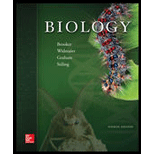
The process whereby a cell’s morphology and function change is called
- a. determination.
- b. cell fate.
- c. differentiation.
- d. genetic engineering.
- e. both a and c.
Introduction: Cell responds to positional information through four processes, namely cell division, cell migration, cell differentiation, and cell death. Cell differentiation is required during the development of the organism in order to ensure the maintenance of proper orientation and morphological form by the organism.
Answer to Problem 1TY
Correct answer: The morphology and function of a cell change by differentiation. Hence, the correct answer is option c.
Explanation of Solution
Reason for correct answer:
Cell differentiation allows cell to acquire a highly specialized functions permanently. Cell determination, which usually occurs during the earlier stages of development, determines the fate of cells. Followed by, differentiation occurs during the later stages of development in order to ensure the production of various tissues that are found in the fully developed organism. Undifferentiated cells undergo cell differentiation to yield cells that possess a specific structure and function. Hence, the morphology and function of a cell changes by differentiation.
Option c. is given as “differentiation”.
The process by which a cell’s morphology and function change is called differentiation. Hence, the correct answer is option c.
Reasons for incorrect answer:
Option a. is given as, “determination”.
Cell determination is the process by which the fate of cells is determined. A complex interaction of signals, cofactors, and transcriptional factors help in determining the role that each cell will play in the fully developed organism. Cells get committed to become a particular cell type and to play a specific role in the adult organism. This does not lead to changes in morphology or function. By cell determination, only the fate is decided and the cells are still in an undifferentiated state. Hence, option a. is incorrect.
Option b. is given as, “cell fate”.
Cell fate refers to the role that particular cells will play in a mature organism. Cell fate is determined by a process called cell determination. Cell fate does not describe a process. This term describes the role that the cells are committed to play in an organism. Hence, option b. is incorrect.
Option d. is given as, “genetic engineering”.
Genetic engineering refers to the process of manipulation of the genetic content of an organism artificially. Such modified organisms perform the functions and express the proteins desired by the scientist. Changes may be induced in the morphology and function of cells as a result of genetic engineering, but such changes occur after the gene product has been expressed. Genetic engineering does not directly lead to changes in morphology and function of the cells. Hence, option d. is incorrect.
Option e. is given as, “both a and c”.
Option c. is correct because undifferentiated cells undergo cell differentiation to yield cells with specific structure and function. Hence, the morphology and function of a cell change by differentiation. Cell determination does not lead to changes in the morphology or function. In cell determination process, only the fate is decided and the cells are still in an undifferentiated state. Thus option a. is incorrect. Hence, option e. is incorrect.
Hence, the options a., b., d. and e. are incorrect.
Thus, undifferentiated cells undergo cell differentiation to yield cells having a specific structure and function. Hence, the morphology and function of a cell change by differentiation.
Want to see more full solutions like this?
Chapter 19 Solutions
Biology
- Which of the following is not a DNA binding protein? 1. the lac repressor protein 2. the catabolite activated protein 3. the trp repressor protein 4. the flowering locus C protein 5. the flowering locus D protein 6. GAL4 7. all of the above are DNA binding proteinsarrow_forwardWhat symbolic and cultural behaviors are evident in the archaeological record and associated with Neandertals and anatomically modern humans in Europe beginning around 35,000 yBP (during the Upper Paleolithic)?arrow_forwardDescribe three cranial and postcranial features of Neanderthals skeletons that are likely adaptation to the cold climates of Upper Pleistocene Europe and explain how they are adaptations to a cold climate.arrow_forward
- Biology Questionarrow_forward✓ Details Draw a protein that is embedded in a membrane (a transmembrane protein), label the lipid bilayer and the protein. Identify the areas of the lipid bilayer that are hydrophobic and hydrophilic. Draw a membrane with two transporters: a proton pump transporter that uses ATP to generate a proton gradient, and a second transporter that moves glucose by secondary active transport (cartoon-like is ok). It will be important to show protons moving in the correct direction, and that the transporter that is powered by secondary active transport is logically related to the proton pump.arrow_forwarddrawing chemical structure of ATP. please draw in and label whats asked. Thank you.arrow_forward
- Outline the negative feedback loop that allows us to maintain a healthy water concentration in our blood. You may use diagram if you wisharrow_forwardGive examples of fat soluble and non-fat soluble hormonesarrow_forwardJust click view full document and register so you can see the whole document. how do i access this. following from the previous question; https://www.bartleby.com/questions-and-answers/hi-hi-with-this-unit-assessment-psy4406-tp4-report-assessment-material-case-stydu-ms-alecia-moore.-o/5e09906a-5101-4297-a8f7-49449b0bb5a7. on Google this image comes up and i have signed/ payed for the service and unable to access the full document. are you able to copy and past to this response. please see the screenshot from google page. unfortunality its not allowing me attch the image can you please show me the mathmetic calculation/ workout for the reult sectionarrow_forward
 Concepts of BiologyBiologyISBN:9781938168116Author:Samantha Fowler, Rebecca Roush, James WisePublisher:OpenStax College
Concepts of BiologyBiologyISBN:9781938168116Author:Samantha Fowler, Rebecca Roush, James WisePublisher:OpenStax College Biology: The Dynamic Science (MindTap Course List)BiologyISBN:9781305389892Author:Peter J. Russell, Paul E. Hertz, Beverly McMillanPublisher:Cengage Learning
Biology: The Dynamic Science (MindTap Course List)BiologyISBN:9781305389892Author:Peter J. Russell, Paul E. Hertz, Beverly McMillanPublisher:Cengage Learning Biology (MindTap Course List)BiologyISBN:9781337392938Author:Eldra Solomon, Charles Martin, Diana W. Martin, Linda R. BergPublisher:Cengage Learning
Biology (MindTap Course List)BiologyISBN:9781337392938Author:Eldra Solomon, Charles Martin, Diana W. Martin, Linda R. BergPublisher:Cengage Learning





